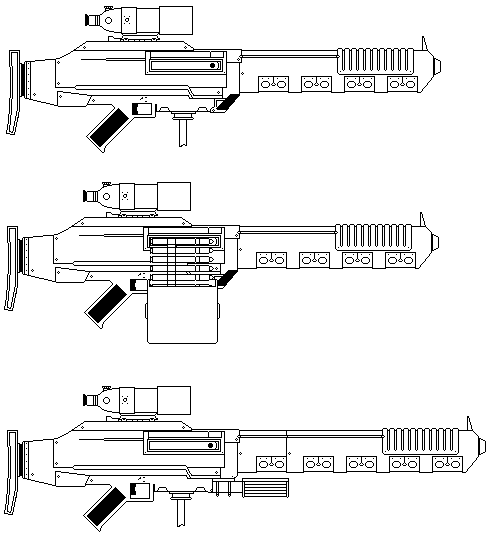
In West Haven's search for a reliable squad support weapon to outfit the new military of the Republic, the Republican Council submitted proposals to several independent manufacturers. Bandito Arms submitted a knock-off of the deadly C-40R Rail Gun, Northern Gun submitted the NG-101 Rail Gun, while the Royal Armory of Desert Star proposed two separate designs - the ISC-2 30 mm Infantry Support Cannon and the RFFC-17 20 mm Rapid-Fire Field Cannon.
Each were put through a series of trials that measured their serviceability, damage capacity, range, accuracy, destructive ability and economical efficiency. Both rail guns had superior range to their counterparts, and while ammunition was far cheaper to produce, routine maintenance - especially in a salt laden environment such as West Haven would prove quite expensive. Furthermore they offered the least destructive capabilities and were grossly overweight compared to the R.A.D.S. proposals. With R.A.D.S. being the final option it was down to the ISC-2 and RFFC-17. Both used electromagnetic coils to accelerate a conventionally fired armor piercing shell which made ammunition expensive and serviceability was marginally better than the previously tested rail guns. The ISC-2 sported a 1,000 foot range advantage over the RFFC-17, fired single shots, and furthermore weighed less. The RFFC-17 though was more durable, sported better corrosion resistance in its eight coil accelerators, and though it consumed more ammunition it inflicted twice the damage of a C-40R rail gun. The one drawback to the ISC-2, when compared to its competitor, was its terrible recoil. Although outfitted with a series of recoil suppression systems it proved inefficient to be used as a squad support weapon as it would require a very strong/robotic/supernaturally strong user to wield it properly.
Thus the RFFC-17 was chosen, an order was submitted for 150 units in addition to a stockpile of ammunition, and rights to license produce the type domestically within Republican Industries. The first units delivered were in 84PA and these were soon dispatched to infantry units across New Haven. Over the next few months, the Type 84 Light Gauss Cannon (As RFFCs are called in West Haven,) began to see service aboard light watercraft, as low flying anti-aircraft guns, pintle mounted weapons on utility vehicles, and so on.
The Type 84s drawbacks though placed it and its users in a dangerous predicament. Unable to defend an infantry unit or vehicle until conventional energy rifle ranges, it fell short of the expectations of the Republican Council and the military of West Haven. Turning to the Royal Armory of Desert Star they requested to test the company's newest variety of infantry deployable Light Gauss Cannon - the RFFC-19. They were rejected outright on account of the RFFC-19 being reserved exclusively for the use of the Kingdom of Desert Star. Thus, the Republican Council turned to its domestic industries to begin researching a way to upgrade the Type 84 LGC to a performance on par with or exceeding that of the RFFC-19.
What little was known about the RFFC-19 derived from accounts gathered through the assistance of Tamiya Elite members who served during the liberation of Desert Star years before. Still only a prototype weapon, during the desperate battle against the occupational forces, it was pressed into frontline military service. Although similiar in size to the Type 84 LGC, the RFFC-19 is heavier, and sports ten gauss accelerators as opposed to the eight found in its predecessor. Republican Industries techs determined that this must be the reason for its superior damage potential. Damage potential aside, it still was believed to have a range no greater than the Type 84 LGC.
Thus, a handful of Type 84 LGCs were taken from Republican Industries and were modified with an extra bank of gauss accelerators to test the theory. Indeed the damage potential of the weapon increased significantly but the range and accuracy did not improve. Drawing a page from archaic weapons manufacturers the technicians opted to create a new 20 mm shell jacketed with tungsten and ferrous metal rings, and then fitted a new and lengthened rifled barrel to the revised version of the Type 84 LGC. The increased density of the shell combined with the rotation of the shells, it was believed, would stabilize the shell en route thus permitting longer range capabilities.
The result of these ingenius experiments was a complete success, not only had West Haven acquired a Light Gauss Cannon that could inflict as much damage as the RFFC-19 but it also increased the maximum range by time and a half, making it the most effective RFFC/LGC known to date! The only drawback was its excessive weight. The Type 84 LGC was designed to be handled by a three man team, one to bear the weapon, one to carry ammunition, and a third to carry a small nuclear power pack. It remained ideal for power armor and vehicular mounts but it required a soldier with superhuman if not supernatural strength to carry and fire the weapon in its intended role as a squad support weapon. While a success - it was apparent that the new design was a stop-gap type at best. Roughly three quarters of the Type 84 LGCs were recalled and refitted as Type 84/86 LGCs.
The Type 84 & 84/86 LGCs began to be retired from frontline service in 98PA, to be replaced by the more versatile Type 98 LGC. Most of those retired were held in reserve for wartime, used in training, or were lend-leased to friendly nations on the Pacific coast. During the Tolkeen War, those remaining in West Haven arsenals were lend-leased to Tolkeen to aid in their fight against the Coalition States. Few are believed to have survived the conflict.